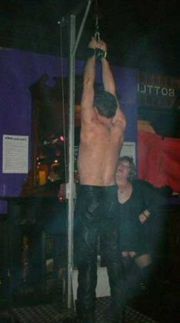Hoist
(typo) |
Speedoslover (Talk | contribs) m (→See also: category) |
||
| (4 intermediate revisions by 2 users not shown) | |||
| Line 1: | Line 1: | ||
[[Image:Hoist if.jpg|thumb|A hoist from http://www.infernalmechanix.com]] | [[Image:Hoist if.jpg|thumb|A hoist from http://www.infernalmechanix.com]] | ||
| − | A '''hoist''' is a large piece of [[dungeon]] equipment designed to lift the captive, either during [[suspension bondage]] or to stretch them in a similar manner to a [[rack]]. A hoist can be built as part of a [[bondage frame]] or as a piece of furniture in its own right. A hoist consists of a base, wide enough to be stable, and an upright support about 2.5m high with a cross beam to which a | + | A '''hoist''' is a large piece of [[dungeon]] equipment designed to lift the [[captive]], either during [[suspension bondage]] or to stretch them in a similar manner to a [[rack]]. A hoist can be built as part of a [[bondage frame]] or as a piece of furniture in its own right. A hoist consists of a base, wide enough to be stable, and an upright support about 2.5m high with a cross-beam to which a pulley is fixed. A winch (either electrical or mechanical) is mounted on the upright and provides the mechanism for raising the captive via a cable and pulley. |
| − | It is possible to use a hoist in a number of different ways. The simplest is to connect the captive's wrists to the end of the cable. | + | Depending on the layout of the room, it is also possible to use structural elements of the building to construct a hoist. Old industial conversions are often suitable for this as they have strong walls to attach the winch to and exposed beams in the ceiling space for pulleys etc. As with any bondage topic, the most important aspect is safety. Overhead fixing points should be bolted through the beam or special joist hangers used ([http://www.fetters.co.uk Fetters] sell a range of winches and overhead fixing points). Wood screws should not be used, as they are not designed to support loads in this way. Investigate tool suppliers and yachting chandlers for winches and pullies. |
| + | |||
| + | It is possible to use a hoist in a number of different ways. The simplest is to connect the captive's wrists to the end of the cable; [[suspension bar]]s allow the captives arms (or legs) to be spread. Longer suspension bars can be used with rope bondage to create suspended [[hogtie]]s. For longer term bondage, a [[suspension harness]] will increase considerably the length of time you can keep the captive suspended. Another popular addition to a hoist (found in many [[clubs]]) is a [[strap cage]]; this is a tube formed of leather straps (a little like a string bag) and uses the captive's weight to cocoon them and prevent escape. | ||
==See also== | ==See also== | ||
| Line 12: | Line 14: | ||
| − | [[Category: | + | [[Category:Furniture]] |
Latest revision as of 01:14, 3 May 2010

A hoist is a large piece of dungeon equipment designed to lift the captive, either during suspension bondage or to stretch them in a similar manner to a rack. A hoist can be built as part of a bondage frame or as a piece of furniture in its own right. A hoist consists of a base, wide enough to be stable, and an upright support about 2.5m high with a cross-beam to which a pulley is fixed. A winch (either electrical or mechanical) is mounted on the upright and provides the mechanism for raising the captive via a cable and pulley.
Depending on the layout of the room, it is also possible to use structural elements of the building to construct a hoist. Old industial conversions are often suitable for this as they have strong walls to attach the winch to and exposed beams in the ceiling space for pulleys etc. As with any bondage topic, the most important aspect is safety. Overhead fixing points should be bolted through the beam or special joist hangers used (Fetters sell a range of winches and overhead fixing points). Wood screws should not be used, as they are not designed to support loads in this way. Investigate tool suppliers and yachting chandlers for winches and pullies.
It is possible to use a hoist in a number of different ways. The simplest is to connect the captive's wrists to the end of the cable; suspension bars allow the captives arms (or legs) to be spread. Longer suspension bars can be used with rope bondage to create suspended hogties. For longer term bondage, a suspension harness will increase considerably the length of time you can keep the captive suspended. Another popular addition to a hoist (found in many clubs) is a strap cage; this is a tube formed of leather straps (a little like a string bag) and uses the captive's weight to cocoon them and prevent escape.